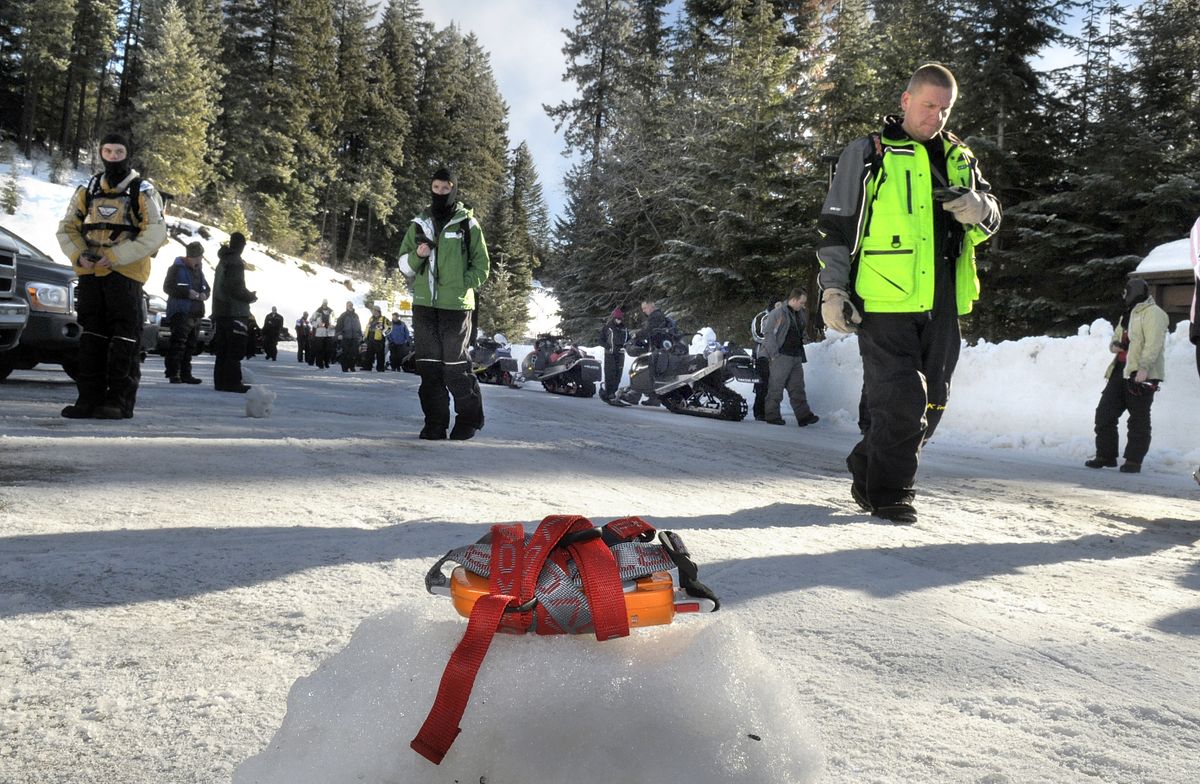Snowmobilers get avalanche of tips
Recent snow slide fatalities help drive outdoor enthusiasts to safety class

FOURTH OF JULY PASS, Idaho – Ninety-two percent of people caught in avalanches will survive if they’re dug out of the snow within 15 minutes.
So time was critical Saturday at Idaho’s Fourth of July Pass, where two dozen snowmobile enthusiasts gathered to practice their rescue skills.
“It’s 12:04 … You’re on the clock,” shouted Rich Gummersall, as a team of four people scrambled up a snowy hillside during a drill. Their goal: Use avalanche beacons to find another transmitter buried on the slope.
The group fanned out, tracking the signal of the transmitter, which was hidden under 2 feet of snow. They finished digging it out at 12:09 p.m., a five-minute response time.
The quick response pleased Gummersall, an education coordinator for the Idaho Department of Parks and Recreation, which put on the free Avalanche Awareness class. On a real rescue, the next step would be to clear the avalanche victim’s airway, he said.
Lanny Neipert was surprised by the surge of adrenaline that swept through him, even in a practice situation.
“There was a lot of confusion,” said Neipert, a 12-year veteran of snowmobiling who signed up for the class to increase his familiarity with beacons.
Digging through the crusty snow also was harder than Neipert expected. In a real avalanche situation, digging would be even more difficult because the snow “sets up like cement,” Gummersall said.
In the six-hour class, snowmobilers learned the basics of avalanche safety, rescue and survival. News of recent avalanche fatalities helped fill up the class. Since mid-December, avalanches have caused 23 deaths in North America, including eight snowmobilers who died south of Fernie, B.C.
“We’re here because we do more and more extreme riding,” said Laroy Dowd, of Rathdrum, who came to the class with his friend James Mittelstadt, also of Rathdrum.
The two men often head to Priest Lake or British Columbia with their machines. They prefer slopes of 30 to 45 degrees – where most avalanches start – and powdery bowls. “Those are fun for us,” Dowd said.
They picked up a number of tips Saturday to make their outings safer, while still providing the rush they crave. After the class, both men also said they planned to buy beacons so they’d be easier to locate if they get buried in a slide.
“We’ve got high-dollar sleds, but neither of us has got a beacon yet,” Dowd said.
Mark Mathieson, of Spokane, used the class to increase his store of backcountry knowledge. He just got back from a trip to Canada, where the recent deaths are uppermost in people’s minds.
Mathieson took two snowmobiles with him on the trip to Red Mountain near Rossland, B.C., but the machines stayed in the trailer. The risk of avalanche danger in the area he wanted to ride was too extreme, he said.
Crystal blue skies meant it was a busy day at the Fourth of July trailhead. While other snowmobilers roared by them, Mathieson and other class members knelt in the snow and learned how to dig test pits.
The pits give a history of the snowpack, said instructor Roger Howard. Backcountry skiers and snowmobilers can quickly learn if a layer of heavy, wet snow is riding on a lighter, unstable base.
“That hoarfrost we had at the beginning of the winter is still there,” said Howard, poking at a layer in a 2-foot column of snow.
Hoarfrost looks like glittering shards of ice on top of the snow. It’s beautiful, but can be deadly, Howard said.
“It’s like cornflakes,” he said. New snow doesn’t bond to it, and the lack of adhesion can trigger an avalanche under the right conditions.
The column of snow that Howard examined Saturday was relatively stable. Breaking the column free from surrounding snow – which is part of the pit test – took a fair amount of strength.
“But it’s different every time you go out,” Howard said.
And the snowpack on each slope is different, too, he added.